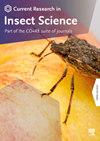Antioxidants, oxidative stress and reactive oxygen species in insects exposed to heat
IF 2.7
Q1 ENTOMOLOGY
引用次数: 0
Abstract
In response to high temperatures, insect metabolic rates increase, favoring the release of higher amounts of reactive oxygen species (ROS). These ROS need to be counteracted by antioxidants to avoid oxidative stress, which can lead to cell damage and death. In this manuscript, we review evidence in insects showing the effects of high temperatures on ROS production, the antioxidant defenses reported in insects in response to high and extremely high temperatures and the extent to which they contribute to preventing oxidative damage. Endogenously produced antioxidants can be enzymatic or non-enzymatic and are involved in heat responses in at least seven insect orders. Our review indicates that evidence is very limited for the effect of high temperature on ROS production, but it clearly shows that at least one antioxidant is upregulated during short-term heat exposure. However, the effects of antioxidants in effectively reducing oxidative damage in biomolecules are still poorly supported by evidence. Dietary-dependent antioxidants show strong potential for coping with heat stress, but evidence is limited, although numerous plants produce antioxidant compounds and a great number of insect species feed on plants. The role of antioxidants in heat acclimation and adaptation is promising but evidence is still very limited in insects. Antioxidants also protect from other prooxidant conditions such as pesticide exposure, nutrient stress, or new biotic interactions, which often act in combination. Potential trade-offs between antioxidant use to different functions could define insect survival and pace of life in response to multiple stressors, including high temperatures. Our literature review indicates that there is only limited evidence of the role of antioxidants in preventing oxidative damage caused by heat, opening the possibility that ROS production might be mitigated by the action of uncoupling proteins or degradation of mitochondria. Finally, we conclude by proposing promising research avenues to gain a deeper understanding of the role of ROS and antioxidants in the oxidative balance of insects exposed to mild and extreme heat.
受热昆虫的抗氧化剂、氧化应激和活性氧
在高温下,昆虫的代谢率增加,有利于释放更多的活性氧(ROS)。这些活性氧需要被抗氧化剂抵消,以避免氧化应激,这可能导致细胞损伤和死亡。在这篇文章中,我们回顾了高温对昆虫活性氧产生影响的证据,昆虫在高温和极高温下的抗氧化防御以及它们在防止氧化损伤方面的作用。内源性产生的抗氧化剂可以是酶促或非酶促的,并且至少在7个昆虫目中参与热反应。我们的综述表明,高温对ROS产生的影响的证据非常有限,但它清楚地表明,至少有一种抗氧化剂在短期热暴露中上调。然而,抗氧化剂在有效减少生物分子氧化损伤方面的作用仍然缺乏证据支持。饮食依赖性抗氧化剂显示出应对热应激的强大潜力,但证据有限,尽管许多植物产生抗氧化剂化合物,许多昆虫物种以植物为食。抗氧化剂在热驯化和适应中的作用是有希望的,但在昆虫中的证据仍然非常有限。抗氧化剂还可以防止其他促氧化条件,如农药暴露、营养压力或新的生物相互作用,这些通常是联合作用的。在抗氧化剂使用与不同功能之间的潜在权衡,可以决定昆虫在应对多种应激源(包括高温)时的生存和生活节奏。我们的文献综述表明,只有有限的证据表明抗氧化剂在预防由热引起的氧化损伤中的作用,这开启了ROS产生可能通过解偶联蛋白或线粒体降解的作用而减轻的可能性。最后,我们提出了有希望的研究途径,以更深入地了解ROS和抗氧化剂在暴露于温和和极端高温的昆虫氧化平衡中的作用。
本文章由计算机程序翻译,如有差异,请以英文原文为准。
求助全文
约1分钟内获得全文
求助全文
来源期刊

Current Research in Insect Science
Agricultural and Biological Sciences-Animal Science and Zoology
CiteScore
3.20
自引率
0.00%
发文量
22
审稿时长
36 days
 求助内容:
求助内容: 应助结果提醒方式:
应助结果提醒方式:


